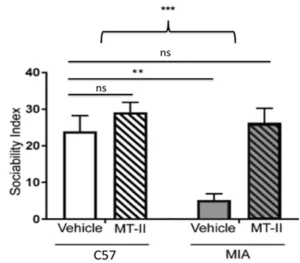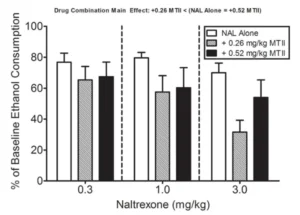



Categories: Melanotan Peptides
What is Melanotan2 (MT-2)?
Velanotan 2 (MT-2) is a svnthetic version of human alpha-melanocyte-stimulatinahormone (a-MSH). lt was originally developed in the 1980s, at the University of Arizonaafter it was found that a-MSH caused sexual arousal in rodents as well as darkening ofthe skin. Originally designed as a sunless tanning option, MT-2 was eventually found tonave a wide range of effects such as: in
increasind sexua arousa
promoting tanning or skin pigmentation,
reducing compulsive behavior.
controlling addiction.
fighting hunger,
reducing glucagon production, and
reversing features of autism.
Melanotan 2 Peptide Structure
Peptide Sequence: Nle-Asp(1)-His-D-Phe-Arg-Trp-LyS(1)
Molecular Formula: C50H69N1509
Molecular Weight: 1024.198 g/mol
PubChem ClD: 92432
CAS Number: 121062-08-6

Melanotan 2 Research
Melanotan 2 and Melanocortin Signaling
Melanotan 2 produces its effects by binding with melanocortin receptors. There are fiveknown melanocortin receptors, each with different function. MT-2 is known to bindprimarily to MC-4R and MC-1R, but also binds weakly to MC-3R
MC-1R: Found on melanocytes, stimulation of MC-1R causes darkening of the skinand hair.
MC-2R: Found in the adrenal glands, MC-2R binding promotes the secretion of adrenalhormones, such as cortisol.
MC-3R: MC-3R is involved in appetite control and energy requlation, but little else isknown about this receptor.
MC-4R: Stimulation of MC-4R causes changes in feeding and sexual behavior. lt alsoaffects male erectile function and energy homeostasis
MC-5R: MC-5R is expressed on sweat glands and pancreatic islet cells
Melanotan 2 and Autism
The newest research finding for MT-2 indicates that the peptide can reverse certainautistic features in a commonly used mouse model of autism spectrum disorder (ASD)There is no treatment for the condition, but recent search has indicated that oxytocintherapy may be useful in mitigating some of the behavioral problems associated withASD. Using a mouse model of maternal immune activation known to lead to autism,researchers investigated whether MT2, which is known to stimulate oxytocin release.could counteract ASD or reduce common ASD behviors. Their research revealed thatadministration of MT-2 reverses the decreased communication, impaired socialinteraction, and repetitive behaviors associated with autism in this particular model. Infact, the researchers found that MT-2 administration increased the expression of oxytocinreceptors in specific parts of the brain, suggesting a direct correlation between oxytocinsignaling in those areas and ASD-specific behaviors[1].

These findings not only suggest potential avenues for developing a treatment for ASDthey have helped to define a specific brain pathway that may be integral to thedevelopment of ASD in the first place. These findings could help scientists develop acomplete model ofASD and thus both treatments and preventative measures.
Melanotan 2 and Hunger
There is good evidence to suggest that MT-2 can reduce fat storage and hunger behaviorin animal models. Researchers have found that the melanocortin-4 receptor (MC-4R)plays a role in food preferences and intake and that MT-2 is a potent agonist of MC-4R.Administration of MT-2 to mice causes significant reductions in how much food theyconsume, but also changes their preference for fatty foods. Mice given MT-2 ignore fattyfoods, which they would otherwise prefer. Similarly, mice devoid of the MC-4R receptorconsume fatty foods almost exclusively and are immune to the effects of MT-2[2].
The effects of MT-2 are similar to those of the hormone leptin, sometimes called thesatiety hormone because it reduces cravings and food intake. Leptin, however, has neverbeen useful in the treatment of obesity, even in individuals who are leptin deficient. This islikely because there are two pathways for satiety, called leptin-dependent and leptin-independent pathways. Research suggests MT-2 is more effective in stimulating bothpathways and thus may be a more effective exogenous treatment for reducing hunger[3], [4]. This latter finding has been bolstered by the discovery that thyrotropin-releasinghormone (TRH) gene expression, which has long been known to play a role in the leptin-satiety pathway, is also affected by MC-4R stimulation[5]. Both MT-2 and leptin arethought to cause an increase in TRH expression in the paraventricular nucleus of thehypothalamus, a region of the brain associated with satiety and food intake, but only MT-2 crosses into the central nervous system in concentrations high enough to have an effecton TRH expression.
Melanotan 2 and Diabetes
The pathogenesis of diabetes is defined by high blood sugar levels, hypersecretion ofglucagon, and the production of ketone bodies[6]. lt has been known for some time thatleptin counteracts these factors by increasing the uptake of glucose, suppressingglucagon production, and interfering with the pathway that leads to ketone bodyformation. These actions do not depend on insulin and thus leptin signaling is beingactively investigated as an alternative means by which diabetes might be treated.
Research has revealed that leptin’s effects on blood sugar are regulated throughmelanocortin receptors and that MT-2 produces similar effects[7]. This is significantbecause leptin has its primary effects in the brain but does not cross the blood-brainbarrier as readily as MT-2. Thus, exogenously administered leptin does not reach theCNS in substantial quantities, a fact that reduces its effectiveness as a drug and handsan advantage to MT-2 even though the effects of the two peptides on melanocortinreceptors are nearly identical.
Melanotan 2, impulse Control and Alcohol intake
In keeping with the idea that MT-2 may affect oxytocin signaling and thus behavior inASD, research also reveals that the MC-4R receptor may play a role in impulse controlPast studies in rats have shown that administration of MT-2 reduces alcohol intake andincreases water intake even in rats that prefer alcoholl8. More recently, research hasrevealed that melanotan-2 works synergistically (boosting efficacy more than seven-foldwith naltrexone to blunt binge-like ethanol intake in mice[9].

These findings suggest that MT-2 might not only be an effective treatment in alcohol-related disorders, but that the peptide is tapping into a more fundamental process ofcraving and desire in the mammalian brain. This research may open up pathways to adeeper understanding not just of alcohol abuse and hunger, but the role of oxytocin inimpulsive behavior. lt may even help researchers identify craving pathways and advanceour understanding of human motivation in aspects of life ranging from work torelationships.
Melanotan 2 and Erectile Dysfunction
Erectile dysfunction (ED) is often attributed to vascular issues and can be effectivelytreated in a majority of men via sildenafil (Viagra) and other drugs that improve blood flowby reducing vascular resistance. Not all ED is due to vascular issues, however, and sosildenafil and similar drugs are ineffective in a small percentage of men and in the vastmajority of women who suffer from hypoactive sexual desire disorder. it has long beenknown that MT-2 is an effective treatment for ED, but research suggests that it may havemore wide-ranging application than drugs like sildenafil due to its actions in the centralnervous system. In a study of men who had failed treatment with Viagra, eighty percentresponded to MT-2 treatment[1o]. MT-2 has been actively investigated in the past as atreatment for both male and female sexual desire disorders.
Future MT-2Research
MT-2 is a heavily re.earched peptide, particularly regarding human behavior, sexualdesire, and impulsecontrol. The peptide, in various forms, has been investigated inclinical trials, thoughproblems with routes of administration have forced scientists back tohere is active and ongoing research into the benefits of this particularthe drawing board.peptide.
MT-2 exhibits minimal to moderate side effects, low oral and excellent subcutaneousbioavailability in mice. Per kg dosage in mice does not scale to humans. MT-2 for sale at PEPTIDE GURUS is limited to educational and scientific research only, not for humanconsumption.Only buy MT-2 if you are a licensed researcher.
Article Author
The above literature was researched, edited and organized by Dr. Logan, M.D. Dr. Logarholds a doctorate dearee from Case Western Reserve University School of Medicine anda B.S.in molecular biology.
Scientific JournaAuthor
Dr. Wessells is a UW professor, chair of the Department of Urology, and has served onseveral national and international professional and government committees, including theWHO International Consultations on Erectile and Sexual Dsyfunction, an NiDDK workinggroup on urological complications of diabetes, and a NlH symposium on diabetes, He is asurgeon, researcher and expert on urogenital trauma and erectile dysfunction, His clinicanterests include reconstructive surgery of the genitourinary tract, acute iniurymanagement and complex surgery for male sexual dvsfunction, His research interestsare in urogenital trauma epidemiology and management; the physiology andpathophysiology of erectile dysfunction; reconstructive surgery; crash iniury mechanics,and urological complications of diabetes. A proerectile melanocortin agonist developed byDr. Wessells and his collaborators at the University of Arizona is in clinical trials for thetreatment of erectile dysfunction.
Dr. Wessells is being referenced as one of the leading scientists involved in the researchand development of Melanotan 2. In no way is this doctor/scientist endorsing oradvocating the purchase, sale, or use of this product for any reason. There is no affiliationor relationship, implied or otherwise, between PEPTIDE GURUS and this doctor. Thepurpose of citing the doctor is to acknowledge, recognize, and credit the exhaustiveresearch and development efforts conducted by the scientists studying this peptide. Dr.Wessells is listed in [11l and [12l under the referenced citations.
Referenced Citations
1.E. Minakova et al.,“Melanotan-l reverses autistic features in a maternal immuneactivation mouse model of autism,” PLoS ONE, vol. 14, no.1, Jan. 2019.
2.A. van der Klaauw et al., “Role of melanocortin signalling in the preference fordietary macronutrients in human beings,” Lancet Lond. Engl., vol. 385 Suppl 1, p.S12.Feb.2015.
3.H, Shimizu,K, lnoue, and M, Mori,“The leptin-dependent and -independentmelanocortin signaling system: regulation of feeding and energy expenditure,” J.Endocrinol.,vol.193,no.1,pp.1-9,Apr. 2007.
4.C.Bjgrbaek and A.N.Hollenberg, “Leptin and melanocortin signaling in thehypothalamus,”Vitam.Horm.,vol.65,pp.281-311,2002.
5.F. Guo, K. Bakal, Y, Minokoshi, and A.N.Hollenberg, “Leptin Signaling Targets theThyrotropin-Releasing Hormone Gene Promoter in Vivo,” Endocrinology, vol. 145no.5,pp.2221-2227,May 2004
6.Y. H. Lee, M.-Y. Wang, X.-X. Yu, and R. H. Unger, “Glucagon is the key factor inthe development of diabetes,” Diabetologia, vol.59, no.7,pp.1372-1375,2016
7.C. Toda et al., “Distinct effects of leptin and a melanocortin receptor agonistinjected into medial hypothalamic nuclei on glucose uptake in peripheral tissues,Diabetes,vol.58,no.12,pp.2757-2765,Dec.2009.
8.D.A. York, S. Boghossian, and M. Park-York, “Melanocortin activity in theamygdala influences alcohol intake,” Pharmacol. Biochem. Behav., vol. 98, no. 1.pp.112-119, Mar. 2011.
9.M. Navarro, F. Carvajal, J. M. Lerma-Cabrera, l. Cubero, M. J. Picker, and T. EThiele, “Evidence that Melanocortin Receptor Agonist Melanotan-ll SynergisticallyAugments the Ability of Naltrexone to Blunt Binge-Like Ethanol Intake in MaleC57BL/6JMice,”Alcohol. Clin.Exp.Res., vol.39, no.8, pp.1425-1433, Aug2015.
10.*Synthetic melanotropic peptide initiates erections in men with psychogenic erectiledysfunction: double-blind, placebo controlled crossover study. – PubMed – NCBl.”[Online].Available:[Accessed: 15-May-2019]..
11.WESSELLS, H. , HRUBY, V. J., HACKETT, J., HAN, G., BALSE-SRINIVASAN, P.and VANDERAH, T.W. (2003), MT-ll Induces Penile Erection via Brain and SpinalMechanisms. Annals of the New York Academy of Sciences, 994: 90-95.
12.Wessells, H.(1998).Synthetic melanotropic peptide initiates erections in men withpsychogenic erectile dysfunction: Doubleblind placebo controlled crossover studyNature.com.Available at:
13.M.T. lslam et a/., “Vasopressin neurons in the paraventricular hypothalamuspromote wakefulness via lateral hypothalamic orexin neurons,” Curr, Bio. CB, ppS0960-9822(22)01121-6,Jul.2022,doi: 10.1016/j.cub.2022.07.020.
14.J. K. Y. Lau et al., “Melanocortin receptor activation alleviates amyloid pathologyand glial reactivity in an Alzheimer’s disease transgenic mouse model,” Sci. Rep.vol.11,no.1,p.4359,Feb.2021,doi: 10.1038/s41598-021-83932-4.
ALL ARTICLES AND PRODUCT INFORMATION PROVIDED ON THIS WEBSITE AREFOR INFORMATONAL AND EDUCATIONAL PURPOSES ONLY.
The products offered on this website are furnished for in-vitro studies only. In-vitro studies(Latin: in glass) are performed outside of the body. These products are not medicines ordrugs and have not been approved by the FDA to prevent, treat or cure any medicalcondition, ailment or disease. Bodily introduction of any kind into humans or animals isstrictly forbidden by law.
PeptideGurus is a leading supplier of American-made research peptides, offering top-quality products at competitive prices. With a focus on excellence and customer service, they ensure a secure and convenient ordering process with global shipping.
CONTACT